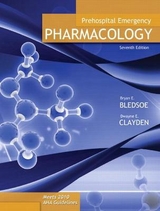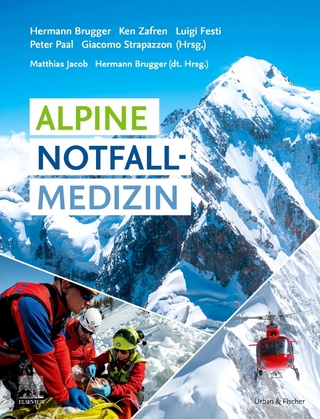
Prehospital Emergency Pharmacology
Pearson (Verlag)
978-0-13-150711-1 (ISBN)
- Titel erscheint in neuer Auflage
- Artikel merken
sets the standard for the
medications and IV fluids that are used in prehospital care. This best-seller
serves as a complete pharmacology text, as well as a handy reference to the
most common drugs and fluids used in EMS.
DR. BRYAN BLEDSOE Dr. Bryan Bledsoe is an emergency physician with a special interest in prehospital care. He received his B.S. degree from the University of Texas at Arlington and his medical degree from the University of North Texas Health Sciences Center/Texas College of Osteopathic Medicine. He completed his internship at Texas Tech University and residency training at Scott and White Memorial Hospital/Texas A&M College of Medicine. Dr. Bledsoe is board certified in emergency medicine. Prior to attending medical school, Dr. Bledsoe worked as an EMT, a paramedic, and a paramedic instructor. He completed EMT training in 1974 and paramedic training in 1976 and worked for 6 years as a field paramedic in Fort Worth, Texas. In 1979, he joined the faculty of the University of North Texas Health Sciences Center and served as coordinator of EMT and paramedic education programs at the university. Dr. Bledsoe is active in emergency medicine and EMS research. He is a popular speaker at state, national, and international seminars and writes regularly for numerous EMS journals. Dr. Bledsoe is on the faculty of the University of Nevada, Las Vegas. He is active in educational endeavors with the United States Special Operations Command (USSOCOM) and co-chairs their Certification and Evaluation Board (CEB). Dr. Bledsoe has authored several EMS books published by Brady, including Paramedic Care: Principles & Practice, Essentials of Paramedic Care, Intermediate Emergency Care: Principles & Practice, Critical Care Paramedic, Anatomy & Physiology for Emergency Care, Prehospital Emergency Pharmacology, and Pocket Reference for ALS Providers. He is married to Emma Bledsoe. They have two children, Bryan and Andrea,and a grandson, Andrew, and live on a ranch south of Dallas, Texas. He enjoys saltwaterfishing and warm latitudes.
Preface
Acknowledgments
About the Authors
Notices
Precautions on Bloodborne Pathogens and Infectious Diseases
1. General Information
Objectives
Introduction
Drug Research and Bringing a Drug to Market
FDA Classification of Newly Approved Drugs
New Drug Development
Unlabeled Uses of Drugs
Medical Oversight
Components of a Drug Profile
Important Pharmacological Terminology
Summary
2. Pharmacokinetics and Pharmacodynamics
Objectives
Introduction
Pharmacology
Pharmacokinetics
Review of Physiology of Transport
Pharmacodynamics
Summary
3. Administration of Drugs
Objectives
Introduction
Patient Care Using Medications
The Medication Order
Six Rights of Medication Administration
General Administration Routes
Drug Administration and Preparation
Medical Direction
Medical Asepsis
Disposal of Contaminated Equipment and Sharps
Medication Routes Used in Emergency Medicine
Pediatric Administration Techniques
Summary
4. Drug Dosage Calculations
Objectives
Introduction
Section 1: The Metric System
Section 2: Find the Ordered Dose
Section 3: Find the Units per Kilogram
Section 4: Concentration Problems
Section 5: Calculate an IV Drip
Section 6: Calculate an IV Drip Based on Patient Weight
Section 7: Milliliters per Hour to Drops per Minute
Practice Problems
5. Fluids, Electrolytes, and Intravenous Therapy
Objectives
Introduction
Fluids
Electrolytes
Cell Physiology
Blood
IV Therapy
Insertion of Indwelling IV Catheter
Collection of Blood Samples for Laboratory Analysis
Blood Transfusions
Summary
6. The Autonomic Nervous System
Objectives
Introduction
The Autonomic Nervous System
Summary
7. Drugs Used in the Treatment of Cardiovascular Emergencies
Objectives
Introduction
Oxygen
Sympathomimetics
Sympathetic Blockers
Antidysrhythmics
Parasympatholytics
Cardiac Glycosides
Anticoagulants
Fibrinolytics
Alkalinizing Agents
Cardiac Pain Management (Analgesics)
Diuretics
Natriuretic Peptides
Antianginal Agents
Antihypertensives
Other Cardiovascular Drugs
Summary
8. Drugs Used in the Treatment of Respiratory Emergencies
Objectives
Introduction
Oxygen
Asthma
Neuromuscular Blockers
Induction Agents
Rapid-Sequence Induction
Pharmacologically-Assisted Intubation
Summary
9. Drugs Used in the Treatment of Metabolic-Endocrine Emergencies
Objectives
Introduction
Diabetes Mellitus
Types of Diabetes
Diabetic Ketoacidosis (Diabetic Coma)
Hypoglycemia (Insulin Shock)
Insulin
Glucagon
Thiamine
Summary
10. Drugs Used in the Treatment of Neurological Emergencies
Objectives
Introduction
Neurological Trauma
Nontraumatic Neurological Emergencies
Summary
11. Drugs Used in the Treatment of Obstetrical and Gynecological Emergencies
Objectives
Introduction
Severe Vaginal Bleeding
Hypertensive Disorders of Pregnancy
Preterm Labor
Summary
12. Toxicological Emergencies in Prehospital Care
Objectives
Introduction
Regional Poison Centers
Patient History
General Approach to the Poisoned Patient
Toxidromes
Specific Toxic Agents Encountered in Prehospital Care
Summary
13. Drugs Used in the Treatment of Behavioral Emergencies
Objectives
Introduction
Understanding Behavioral Emergencies
Summary
14. Drugs Used in the Treatment of Gastrointestinal Emergencies
Objectives
Gastrointestinal Medications
Summary
15. Drugs Used in Pain Management
Objectives
Introduction
Analgesics
Summary
16. Weapons of Mass Destruction
Objectives
Introduction
Personal Protection
NBC Agents Overview
Summary
Appendix A Glossary of Street Drug Names
Appendix B Emergency Intravenous Fluids Quick
Reference Guide
Appendix C Quick Drug Reference
Appendix D Adult Advanced Cardiac Life Support Algorithms
Appendix E Common Home Prescription Drug Information
Appendix F Pediatric Drug Dosages
Appendix G Pediatric Advanced Cardiac Life Support Treatment Algorithm
Appendix H Drug Administration Skills
Appendix I A Guide to Herbal Supplements
Appendix J Practice Problems Answer Key
Index
| Erscheint lt. Verlag | 14.10.2004 |
|---|---|
| Sprache | englisch |
| Maße | 285 x 225 mm |
| Gewicht | 1524 g |
| Themenwelt | Medizin / Pharmazie ► Medizinische Fachgebiete ► Notfallmedizin |
| Medizin / Pharmazie ► Medizinische Fachgebiete ► Pharmakologie / Pharmakotherapie | |
| ISBN-10 | 0-13-150711-7 / 0131507117 |
| ISBN-13 | 978-0-13-150711-1 / 9780131507111 |
| Zustand | Neuware |
| Haben Sie eine Frage zum Produkt? |
aus dem Bereich



